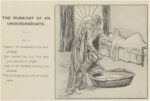The Budgai’at of I’m a-Khrying. E.C.W.
In: London Daily Chronicle. Saturday 04 September 1909, p. 5
Archives
Rubaiyat of a Councillor
Rubaiyat of a Councillor. Dudley F.M. Appleby
In: Newcastle Evening Chronicle, Wednesday 15 February, 1933
6 quatrains
Rudai Rat (fragments of)
Rudai Rat (fragments of). F.W.H.
In: Cheltenham Chronicle – Saturday 15 July 1916
Rubaiyat of a Star
Rubaiyat of a Star
In: The Motion Picture Director, Sept. 1925, p. 20
9 quatrains
The Rubaiyat of an Undergraduate
A Holiday Rubaiyat
A Holiday Rubaiyat
In: Books of To-day and Books of To-morrow, July 1925, p. 14
16 quatrains
Rubaiyat against Intervention
Rubaiyat against intervention. Florence Hagelthorn
In: Advocate (Melbourne, Vic. : 1868 – 1954), 27 Jan 1949, Page 9
5 quatrains
